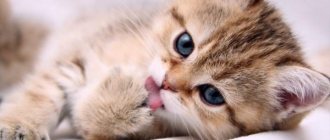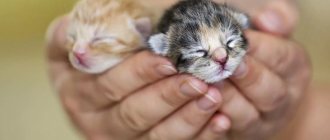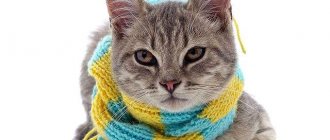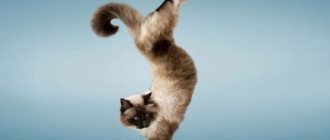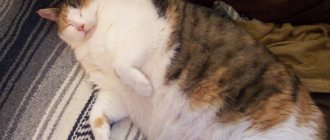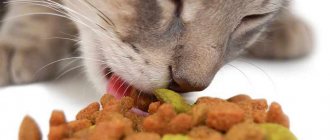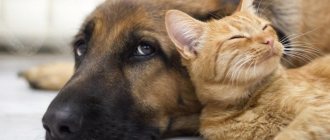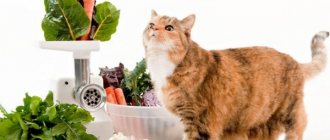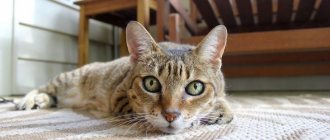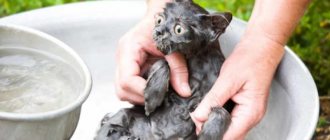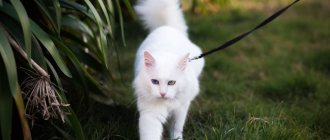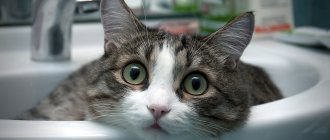Underweight is no less dangerous than obesity. Most often it is associated with poor living conditions and selectivity in food. Because of this, many owners try to cope with the problem on their own and are looking for ways to fatten their cat without seeking help from a veterinarian.
But we must not forget about pathological factors that affect appetite and nutrient absorption. In these cases, the animal requires mandatory treatment, so to be on the safe side, it should be scheduled for examination at a veterinary clinic.
Wasting in cats
It is useless to compare your pet with other animals. The weight norm is individual and depends on:
- genetics;
- age;
- breed affiliation;
- amount of physical activity;
- food quality;
- floor.
For this reason, you should not focus only on weight. In addition to it, other important factors can tell about exhaustion.
Weight standards
It is better to check the norm for a particular cat at the veterinary clinic, but you can give an objective assessment yourself. To do this, you will need to calculate your body mass index.
:
- Measure the circumference of the chest and the distance between the ankle and the knee on one of the hind legs, using centimeters to calculate.
- Divide the first number by 0.7062 and subtract the second number from it.
- Divide the result by 0.9156 and subtract the second number from it.
Thus, the formula for calculation is as follows:
BMI = ((X/0.7062 – Y) / 0.9156) – Y
where BMI is body mass index, X is the circumference of the chest, and Y is the distance between the ankle and knee.
If the result is between 9 and 30, your pet is in excellent shape. We speak of exhaustion when we cross the lower limit, and we speak of obesity when we cross the upper limit. In these cases, it is necessary to reconsider the existing diet and level of physical activity.
When can you talk about lack of mass?
In addition to body mass index, deficiency will be confirmed by visual inspection and palpation. The following signs will indicate exhaustion:
:
- protruding pelvic bones, ribs and spine;
- sunken stomach;
- lack of fat and muscle.
If you know the normal weight of your pet, then to determine the deficiency it is enough to weigh it. Weight loss of more than 10% of the initial value is equated to serious exhaustion.
Food from popular manufacturers
There are medicinal products for weight gain in the veterinary lines of different manufacturers. They are an excellent alternative to eating from the hosts' table.
Royal Canine
If you fed your pet an unbalanced diet, and as a result he began to lose weight, he began to shed hair, began to vomit, and his general condition became lethargic, after the necessary treatment, the doctor will probably recommend you a diet for weight gain.
Gastro Intensinal
One such food is dry granules “Royal Canin Gastro Intensive” moderate calorie. This product contains the following ingredients:
- meat;
- liver;
- fats and oils;
- cereals;
- minerals;
- plant products;
- yeast;
- carbohydrates;
- food and technological additives.
Prescribed to cats losing weight as a result of digestive problems along with taking the necessary medications. Cats that were previously indifferent to dry food invariably show interest in it.
Attention! If you feed your animal dry food, make sure it always has fresh water. It helps improve digestion when taking dry granules.
As a result of feeding Royal canin gastro intestinal, the animal not only actively gains weight, but also sheds less, drinks more, leads a more active lifestyle, and the smell in the cat litter becomes less pungent.
Recovery
To gain weight, manufacturers offer not only dry food, but also canned food. Recovery canned food is prescribed to cats and dogs for recovery during the period of anorexia and after recovery, during intensive care, during pregnancy and feeding offspring, for liver lipidosis in cats, as well as for kittens during the growth period.
It contains the following components:
- meat;
- liver;
- vegetable by-products;
- cereals;
- fats and oils;
- dairy products;
- minerals;
- carbohydrates;
- eggs;
- yeast.
The feeding scheme for anorexia in cats is shown in the figure:
The composition provides the body with all the necessary substances and compensates for the decrease in body weight of cats that are picky eaters. This food is suitable for tube feeding if the animal is unable to feed itself.
Important! When feeding through a nasoesophageal tube with a diameter of less than 3.3 mm, the feed must be diluted with water in a 1:1 ratio.
- hepatic encephalopathy;
- acute pancreatitis and hyperlipidemia.
Purina
The Purina line includes a canned dietary product called Pro Plan Veterinary Diets Gastrointestinal. It is prescribed to animals during the rehabilitation of anorexia and is presented both in the form of croquettes and in the form of canned food.
Gastrointestinal is a complete diet with a high concentration of essential nutrients, easily digestible ingredients, and increased energy value. It contains:
- offal;
- salmon;
- turkey meat;
- animal serum;
- sunflower oil;
- corn starch;
- minerals;
- vitamins.
If a cat loses weight while nursing, she can be given ready-made kitten food or canned food for cats recovering from surgery as a supplement to the main diet.
Attention! Feeding human food to pets is not recommended because it may not provide them with essential nutrients. The same goes for cheap ready-made food.
And in conclusion, it should be said that no matter how much you want your pet to look well-fed and happy, you should not overfeed him. All cats are individual, and even kittens from the same litter can have different body shapes.
Why is the animal skinny?
Sudden weight loss or difficulty gaining weight is due to physiological or pathological reasons. In the second case, the animal always requires the help of a veterinarian, since self-treatment can result in even more serious complications.
Physiological features
Physiological causes are associated with natural internal processes and non-hazardous interactions with the environment. These include:
- Hot weather.
Stuffiness and scorching sun are not the best conditions for eating food. Increased sweating complicates the digestion of incoming foods, so the main preference is given to water.
- Pregnancy
. In the early stages, pregnant cats often exhibit toxicosis. Due to nausea, they refuse their usual portions and lose weight.
- Sexual
hunting
. The hormonal changes observed during this period have only one goal - finding a suitable partner. All other needs, including nutrition, fade into the background. - Lactation
. All the energy of a nursing cat goes into producing milk. Even with normal feeding, she may lose weight due to regular loss of energy. If there are no mistakes on the part of the owner, the condition will normalize on its own after separation from the kittens.
- Stress
. Animals often lose weight due to anxiety, worrying about the loss of a beloved owner, the arrival of a new family member, regular injections or protracted repairs. After eliminating the irritating factors, they quickly recover.
You can handle all of the above situations on your own. But, if you notice alarming signs indicating pathology, take your pet for an examination. In this case, poor appetite and stable weight loss may indicate the presence of a dangerous disease.
Pathological factors
The appearance of pathological factors can be judged by the accompanying symptoms. Depending on the clinical picture, the following diseases can cause exhaustion:
- dental (stomatitis, caries, gingivitis), complicating chewing food due to pain;
- infectious (rinotracheitis, panleukopenia, calcivirosis), causing acute intoxication of the body;
- parasitic, characterized by the destruction of most incoming substances through helminths;
- diabetes mellitus, accompanied by depletion of fat reserves due to an artificial lack of glucose;
- pancreatitis, which impairs the absorption of nutrients;
- oncology, causing digestive disorders and poisoning from a decaying tumor;
- diseases of the endocrine system, reducing the volume of fat and muscle due to hormonal imbalance;
- intestinal and liver pathologies that impair the production of digestive enzymes and the absorption of nutrients.
All these conditions require mandatory treatment. Depending on the severity of the disease, your pet may need medication, a therapeutic diet, or surgery.
Lack of weight with excellent appetite
This situation is typical for forced starvation, when an animal is deprived of a constant source of food for a long time. This includes stray cats and lost pets.
Another possible reason is increased energy consumption. If your pet does not sit still, actively walks outside, plays with other four-legged animals and loves hunting, its portion should be significantly larger than normal. Otherwise, he will expend many more calories than he consumes.
Some picky eaters may not eat for several days, earning pity from their owners. Their main task is to get a more tasty treat instead of food they don’t like. In such cases, you should not succumb to provocations, since regular violation of the feeding regime will sooner or later affect your health.
Causes of thinness
Veterinarians divide the reasons for cat thinness into two types!
The first of them is physiological. It occurs only due to fasting, stressful situations, poor diet and metabolic disorders. These also include:
- Consequence of feeding a large number of offspring.
- Stressful situations and prolonged fasting. For example, your cat spent about a month on the street and then returned. - Due to attacks of vomiting and diarrhea. - Severe dehydration.
- Consequences of intensive treatment.
- Medical error.
- Incompatibility of natural and non-natural food products.
- Metabolic disease.
- Acute dysbacteriosis associated with the consumption of harmful products.
Pathological thinness occurs due to diseases or congenital pathologies in the animal. The only way to cope with it, to make the pussy fatter, is to diagnose the animal’s body and begin progressive treatment.
There are a lot of questions on the Internet: why is a Scottish cat thin, why is a British cat not gaining weight, what should I do to make my pet gain weight? In fact, the causes of underweight do not depend on the breed of pussy. Treatment for different breeds is also similar.
- The causes of thinness in a cat always slow down its metabolism, and it gradually begins to lose weight. The pet will return to normal shape after its diet becomes complete. It is necessary to ensure that the animal does not consume inedible, harmful objects.
- Due to dysbiosis and metabolic disorders, you can seek help from a veterinarian. He will adjust the diet and also prescribe a course of probiotics and vitamins for weight gain to keep your pet healthy.
- However, increasing nutrition does not always help the pet.
If your pet flatly refuses cooked food, this is not normal, and you should consult a doctor who will tell you the nutritional rules for such a case. This symptom may indicate several diseases at once!
We invite you to familiarize yourself with Dragonflies: photos and descriptions of insects, types of dragonflies
There are not many rules for creating a diet for your pet. Under no circumstances should you feed fatty foods, no matter how thin you are. This will put a lot of stress on her liver. The feeding schedule must be followed constantly and always taking into account the healthy and at the same time favorite foods of your cat.
Food should be separate and in small portions, preferably with foods that increase the animal’s energy. You can feed once every 2 hours. Then the pet will definitely gain weight without a distended stomach, as it will gradually decrease in size. And the cat will begin to consume less food. She will begin to move more actively, and her metabolism will gradually return to normal.
- If your cat’s excessive thinness bothers you, then you need to introduce foods such as beef, steamed oatmeal and various types of bran into its diet along with other food for weight gain (vegetable protein).
- Also suitable are scalded chicken or beef liver, chicken and quail eggs (anything that contains much-needed protein). You can boil a small amount of raw sea fish and make a good jelly from cartilage; such a product will also contain a lot of protein.
- Your pet's diet may include dry ready-made cottage cheese, natural yogurt, milk or low-fat cream. You can make him fruit purees and baby food.
Also, do not forget that an experienced veterinarian can tell you what to feed your cat to gain weight.
There are feeds for increasing the weight of animals, called medicinal, but they are more expensive than usual. However, if the pet is in critical condition and does not digest natural food well, this is the only feeding option.
If the weight loss is insignificant, you can fatten your pet with natural products. Weight gain is achieved by intelligently replacing proteins with carbohydrates. It is better to avoid fatty foods (or reduce them to a minimum); strive to gain muscle mass, not fat.
What can you feed your cat to make him fat?
- Meat: rabbit, chicken should be in the diet daily (60-75% of the total diet). To eliminate the risk of infection with worms, meat must be deep frozen (sometimes it can be boiled) before consumption.
- Fish: only oceanic. Make sure that there are no bones in the fish, as they contribute to the development of diseases of the urinary organs.
- Eggs (white and yolk): boiled and raw. Use no more than 2 times a week, 1 pc.
- Dairy products: cottage cheese, sour cream, unsweetened yogurt. It can be introduced into the diet gradually; it is better not to use store-bought products.
- Milk should be completely excluded from the diet of a domestic cat, as it puts a lot of stress on the liver and is poorly digested.
- Hard cheese. Useful in small doses; if overused, it can overload the liver.
- Cereals: rice, buckwheat, millet, etc. 1 teaspoon for each meal.
- Fruits. If the cat doesn’t mind, then you can, but you shouldn’t force feed it.
- Greens: parsley, dill, lettuce. Greens help improve digestion, so it is useful to add them to every meal.
- Oils: sunflower, flaxseed, olive. Only as a supplement.
Your task is to formulate your cat’s daily routine so that the body has to spend as little energy as possible. Reaching the golden mean is difficult, especially if the pet is overly active and picky about food.
Attention! Avoid sausages, canned meat and fish; such products contain a lot of salt and spices. They can harm the cat's digestive system.
It is necessary to review your diet. To speed up the process of weight gain, use vitamin supplements. They activate metabolism, which will force the body to digest and absorb food faster. It is important to consult your veterinarian before using vitamins.
If the cat is recovering quickly, it’s time to organize a special diet for it. However, sometimes, on the contrary, it needs to be fattened. There are reasons for this.
What to feed a domestic cat to make it fat is a pressing question for cat lovers if the illness the animal experienced is left behind. Take, for example, helminthic infestation: when the disease becomes protracted, it is necessary not only to carry out deworming, but also to take care of a balanced, nutritious diet.
However, keep in mind the fact that food alone will not help your pet cope with pests. No matter how much you try to fatten him, the helminths will still grab their “share”. That is why in this case the new diet will need to be combined with medicinal drugs.
Let's say you picked up a stray kitten or a young cat on the street. Most likely, the pet will be quite exhausted from the cruel street life. All that is required of you for your kitten to gain stable weight is just to regularly offer your pet food. When the kitten begins to eat properly, the problem with its thinness will be solved.
Sometimes you will need to feed your cat if the day of the exhibition is approaching. Remember that pets that participate in such events must fully comply with breed standards. If you know that your cat's weight is too low, it's time to switch to a new feeding regimen.
Of course, weight is not the key to winning. The main thing is an aesthetic appearance, state of health, which must be confirmed by special documents, as well as the color and smoothness of the coat. However, if your pet has become too thin before the exhibition, you can safely correct its figure.
What natural foods to feed your cat to make her gain weight
When fattening, you should avoid too fatty foods (pork, lard, cream) and feeding from the human table. Such food worsens the functionality of the gastrointestinal tract, causing new complications.
The main emphasis should be on calorie content, choosing foods with high energy value. It is recommended to include in the menu:
- chicken, rabbit, lamb and veal, containing large amounts of animal protein;
- boiled vegetables (zucchini, pumpkin, carrots), bran and oatmeal, enriched with fiber;
- sea fish, offal, chicken and quail yolks, characterized by a wide variety of vitamins and minerals in their composition;
- fermented milk products with low fat content, which have a beneficial effect on the functioning of the cardiovascular system and the musculoskeletal system;
- jellied cartilage, containing collagen beneficial for joints;
- buckwheat and rice porridge, which normalize peristalsis and digestion.
Instead of milk, it is better to use artificial milk formulas from a pet store. Otherwise, your pet may have digestive problems.
What are the dangers of excessively fattening a pet?
You can fatten a cat only if it is really thin and this negatively affects its health. You should act carefully, adhering to certain rules. However, some owners go beyond all restrictions and begin to feed their pet intensively in order to “improve” its aesthetic appearance. A purring chubby cat looks funnier than a skinny cat, moves much funnier and evokes affection in those around him. But before deliberately harming a pet, the owner should learn about the dangerous consequences of feline obesity:
- Type II diabetes (non-insulin dependent) - even if the animal does not have a tendency to this disease, then an incorrect lifestyle and a disrupted diet can cause its development. As a result, the owner will have to give the pet insulin from time to time to prevent a sharp deterioration in its condition. Veterinarians consider diabetes mellitus to be the most dangerous consequence of overfeeding pets.
- Diseases of the cardiovascular system - the more excess weight a cat has, the higher the load on the heart. Most overweight pets have low motor activity, they mostly lie down and run a little, which leads to a worsening of the situation. Heart pathologies associated with obesity often lead to attacks that provoke a heart attack in the animal.
- Injury to bones and joints - if an obese pet retains its playfulness, then jumping long distances can result in damage to the skeletal system: dislocations, fractures, sprains. Since the articular-ligamentous apparatus is “sharpened” for a certain weight, its significant increase will turn out to be a very traumatic condition.
- Low ability to recover - obese animals take longer to recover from injuries and illnesses, including due to intense stress on joints and other tissues.
- Predisposition to inflammatory joint diseases - arthritis. Statistics show that overweight cats are the first to be at risk for developing this unpleasant disease. The pathology is accompanied by tissue inflammation and curvature of the limbs. In complicated cases, suppuration occurs. Advanced forms of arthritis can only be treated with surgical methods.
- Hypertension – at the initial stage of development, the disease is difficult to diagnose, but it is very dangerous for the health of the pet. Chronic hypertension leads to cardiac hypertrophy, which, with accompanying factors, can result in organ failure.
The owner of a cat should know that for her an extra kilogram and a half is already considered obesity, an unsafe condition for health. Therefore, before feeding your pet intensively, you should find out whether he needs such changes? After all, you can harm an animal even with the help of overprotection, indulging the whims of a purring friend.
Dry food for weight gain
Veterinarians advise paying attention to the treatment line marked Gastro Intestinal. Such feeds are characterized by increased calorie content, which allows you to regain lost volumes in a fairly short time.
If you are underweight, the following options for dry granules
:
- Veterinary Diet Cat Renal from Eukanuba, recommended for the treatment of liver and kidney diseases;
- Senior Consult Stage 2 High Calorie from Royal Canin, suitable for older cats with impaired nutritional absorption;
- Convalescence Support from Royal Canin, designed for recovery from surgery and severely debilitated animals;
- Renal Special RSF 26 Feline from Royal Canin, designed for cats with chronic renal failure.
At first, it is better to replace the “crackers” with wet food from the same line. They have a more pronounced aroma, which helps restore lost appetite. Once they feel better, they can be given out as treats, combined with dry food.
Table: comparative characteristics of dietary feeds of various brands
| Name of food | Class | View | Flavors | Peculiarities | Price |
| Eukanuba Adult Sterilized Weight Control Chicken | Superpremium | Dry | Chicken | Designed for sterilized and neutered male cats |
|
| Hill's Prescription Diet Metabolic Weight Management | Superpremium | Dry | Chicken | Allows you to maintain optimal weight |
|
| Hill's Prescription Diet Metabolic Urinary Weight Care | Superpremium | Dry | Chicken, turkey | Also used for cats with urinary tract diseases |
|
| Hill's Prescription Diet i/d Digestive Care (jelly) | Superpremium | Wet | Chicken | Helps maintain a healthy digestive tract |
|
| Hill's Prescription Diet w/d Digestive/Weight Management | Superpremium | Dry | Chicken | Helps normalize weight in diabetic cats |
|
| Hill's Prescription Diet w/d Digestive/Weight Management (jelly) | Superpremium | Wet | Chicken | Better absorbed by the pet's stomach |
|
| Royal Canin Satiety Weight Management SAT34 | Superpremium | Dry | Chicken, poultry | Can be used for diabetes and urolithiasis |
|
| Royal Canin Neutered Adult Maintenance | Superpremium | Wet | Chicken, pork, poultry, liver | Suitable for sterilized animals in the postoperative period |
|
| Pro Plan Veterinary Diets Feline OM Obesity (Overweight) Management dry | Premium | Dry | Chicken, poultry | Used for adult cats |
|
| Farmina Vet Life Natural Diet Cat Obesity | Premium | Dry | Chicken, pork, poultry | Prevents muscle loss | 2 kg - 1709 rub. |
| Royal Canin Satiety Weight Management (jelly) | Superpremium | Wet | Chicken | Suitable for pets with diabetes |
|
| Purina Pro Plan Veterinary Diets OM pouches | Superpremium | Wet | Chicken | Helps maintain weight |
|
| Happy Cat Adipositas | Superpremium | Dry | Chicken, poultry | Also used for cats with liver disease |
|
| Brit VDC Obesity | Superpremium | Dry | Chicken | Suitable for British cats, grain free | 2 kg - 1240 rub. |
| Forza10 Active Line | Superpremium | Dry | Fish | Consists of heart-shaped granules | 454 g - 470 rub. |
| Enova Breeder Cat Light Indoor | Superpremium | Dry | Chicken, rice | Can be used to feed cats over 7 years of age | 10 kg - 6300 rub. |
| Bosch Sanabelle Light for cats prone to obesity | Superpremium | Dry | Bird | Provides quick satiety due to the large amount of dietary fiber | 2 kg - 1300 rub. |
| Barking Heads Adult Fat Cat Slim | Holistic | Dry | Chicken, salmon | Suitable for pets with sensitive stomachs |
|
| 1st Choice Weight Control | Superpremium | Dry | Chicken | Designed for adult animals | 5.5 kg - 2600 rub. |
Supplements and vitamins – are they necessary?
The need to add vitamins depends on the type of diet. With dry feeding, all the necessary substances are already present in the composition, so additional elements can cause a surplus.
The opposite situation is typical for natural feeding. In this case, vitamins simply must be present in the diet. But even here you can provoke their excess by trusting the advice of friends. It is better to clarify this question with a veterinarian, who will select a ready-made complex for your pet based on the test results.
Is it worth feeding a cat so that it becomes fat, which could lead to obesity?
According to statistics, fat cats live less than their counterparts with normal body weight by 2-3 years. Obesity threatens the following health problems:
- Diseases of the musculoskeletal system. Due to severe stress, the cartilage gradually wears away, causing severe pain, lameness and limited mobility. The risk of injury increases.
- Cardiovascular diseases. The load on the heart increases, the muscle works harder. Plaques appear on the vessels, impeding blood circulation and causing a lack of oxygen.
- Diabetes. The disease develops as a result of a metabolic disorder caused by a lack of insulin production or a decrease in tissue sensitivity to it, due to which carbohydrates that are not properly processed enter the blood.
- Liver pathologies. Fatty deposits appear in the organs, negatively affecting its functioning.
Since excess weight poses a threat to your pet's health, it is necessary to normalize it as soon as possible. First of all, establish the cause. Obesity can be a consequence not only of overfeeding, but also of hormonal imbalance, metabolic disorders, and chronic diseases. The animal is switched to a low-calorie diet and its physical activity is increased.
Sources:
https://porodakoshki.ru/chem-kormit-koshku-dlya-nabora-vesa/ https://usatiki.ru/korm-dlya-koshek-dlya-nabora-vesa/ https://murkoshka.ru/kormlenie/ korm-dlya-koshek-nabora-vesa.html
When to contact a veterinarian
If you are not sure about the cause of exhaustion, sign up for an examination. Taking tests and undergoing an ultrasound will never be superfluous. If there are no alarming symptoms, you can postpone the visit for a couple of days to observe the pet’s behavior.
You should not delay contacting a veterinarian only if your condition steadily worsens, you refuse to eat for more than 2 days, and you lose too much weight. Particular attention should be paid to kittens. They should not fast for more than a day, so a small pet should be taken for examination immediately after a deterioration in appetite.
How to identify excessive thinness in a pet
Due to the large number of breeds, many cats have significant differences in appearance. This is why some people may mistake a slender and lean animal for an emaciated one. You need to know the difference between physiological and pathological thinness.
Signs of a healthy cat with a slender physique:
- the proportions between the sizes of the head, torso and limbs are observed;
- ribs and vertebrae are not visible through the layer of wool, but are easily found when palpated;
- the waist is pronounced;
- there is a thin layer of fat in the chest and abdomen area;
- the animal is active, plays a lot and eats with appetite;
- The coat is smooth, shiny, easy to comb and does not fall out.
Oriental breed cats have well-developed muscle mass and a small layer of fat
With pathological thinness, the following signs are observed:
- protruding shoulder blades, ribs, hip bones are visible to the naked eye;
- the head and ears are sharply enlarged compared to the body, the limbs are thin;
- the muscles are poorly developed, fatty tissue on the abdomen and back cannot be felt;
- the fur falls out in uneven tufts, there may be tangles;
- the animal spends a lot of time sleeping, moves little, and changes in appetite are observed (ravenous hunger or complete lack of desire to eat).
When a cat is emaciated, bones can be seen through the skin.
Features of feeding kittens
Kittens are fed in the same way as adult animals. The only difference is in the volume of portions, frequency of feeding and the list of acceptable foods. If an adult cat needs fewer calories, then kittens need significantly more. In addition, they can be fed up to 8 times a day, but in small portions.
Before all the molars appear, the menu should be less varied, but always balanced. For this reason, it is much easier to use ready-made dry food.
Normal weight value
As a rule, owners of domestic cats are most often faced with the need to limit their pet’s diet. The thing is that animals that spend most of their time within four walls sometimes move too little, and their lifestyle certainly cannot be called active. Hence, a fairly common problem is obesity. If your cat actively begins to gain weight, be prepared for the fact that she may develop heart problems, arthritis and other ailments.
However, excessive thinness of a cat also does not mean anything good. Very often, such consequences occur when the pet becomes ill with a helminthic infestation or its body is affected by other parasites. Try to control the weight of your animal, since normal size is the key to a long life without dangerous diseases.
How to fatten a cat without it being fat
When fattening, it is important not to overdo it, as obesity can cause even more problems. To do this, be sure to control the growing indicator and avoid the most common mistakes.
Weight control
Weigh your pet on a floor or kitchen scale every week. If you gain too quickly, adjust your daily caloric intake or add more activity.
What mistakes should you avoid?
Self-feeding is often accompanied by mistakes. For the safety of your pet, try to avoid sudden changes in diet or mixing different types of food, handouts from the table, uncontrolled eating and infrequent feeding. All these situations can lead to indigestion or obesity.
Causes of cat emaciation: fattening or treating
In some cases, pet weight loss is associated with quite predictable physiological factors:
- Feeding numerous litters.
- Hunger - the cat lives on the street or for some other reason has been deprived of food.
- A combination of stress and hunger - the cat got lost and did not leave a secluded place for a long time.
- Dehydration (severe dehydration) resulting from vomiting and/or diarrhea.
- Medical intervention - after intensive therapy, strict dietary restrictions, complicated pathologies.
- Failure of metabolic processes - metabolic disorders can be congenital or acquired. In the latter case, this may occur due to mixed feeding of natural food and industrial feed.
- Dysbacteriosis – develops as a result of an innate tendency to eat inedible things.
All of the above slows down metabolic processes, the cat slowly, gradually loses weight. But if the owner notices changes in a timely manner and takes appropriate measures, the pet will quickly return to its normal physical shape.
When fattening won't help. However, it is not possible to cope with the problem by strengthening your pet’s diet in all cases. This method will not lead to a positive result:
- When an animal is infected with helminths, it requires anthelmintic therapy.
- If a cat becomes infected with an intestinal infection, the disease is accompanied by diarrhea, vomiting, dehydration and requires comprehensive treatment.
What to do? If your pet refuses to eat, rapidly loses weight, and his condition worsens, then there is no time to waste. You should contact a veterinary clinic for professional help as soon as possible.
The Best Vitamins for Older Cats
When an animal turns 7-8 years old, its health requires increased attention. Cats and kittens are no longer the same as in their youth: their energy levels decrease, their fur becomes dull and falls out, their immunity weakens, and metabolic processes slow down. To maintain the health of aging pets, manufacturers have developed special lines of vitamin preparations and feed additives.
4 Agrovet protection Medical sulfur
In the fourth position of products for aging animals is Medical Sulfur from the company Agrovetzaschita.
Available in the form of sachets of 5 g, which are added to food. Sulfur is an important component for the life of older pets. It actively participates in many metabolic processes in the body, and also serves as a building material for cellular structures. This element is part of many essential amino acids, vitamins, hormones, taurine and other compounds important for the body.
The introduction of a feed additive with sulfur into the daily diet of aging animals contributes to:
- Accelerate metabolism.
- Energy production.
- Synthesis of collagen and keratin.
- Improving the condition of the skin and coat.
It is recommended to give medical sulfur from the company Agrovetzaschita every day, 1 sachet along with the food. The course of treatment is a month.
Owners of older cats choose this veterinary drug for its affordable price, convenient powder form, ease of use, lack of side effects, and benefits for the animal’s body.
Pros:
- Budget cost.
- Ease of use.
- Efficiency.
- Safety.
- Well tolerated by animals.
Minuses:
- Pronounced sulfur odor.
Food additive Agrovetzaschita Medical sulfur for dogs and cats
3 Veda Phytomines 50 g
The third place in the ranking is taken by the feed additive Fitomina from VEDA.
It is used to maintain the health of older cats. The veterinary drug was developed taking into account the characteristics of the body of animals over 8 years old. The food supplement is designed to prevent vitamin deficiency and the occurrence of age-related diseases, strengthen the immune system and, as far as possible, slow down the aging process.
The complex includes a set of vitamins and minerals, extracts of medicinal herbs, bee products, taurine, sulfur, L-carnitine, brewer's yeast, lactose, steamed fish meal.
The drug has the following effect on the body of an elderly animal:
- Reduces blood cholesterol levels.
- Dilates blood vessels.
- Normalizes blood pressure.
- Improves cerebral circulation.
Users choose Phytomins from VEDA for their availability, balanced composition, ease of use, high efficiency, pleasant aroma and taste.
Pros:
- Affordable price.
- Easy to use.
- Balanced composition.
- Prevention of vascular diseases.
- Support for the body of older animals.
- Pleasant taste and aroma.
VEDA Phytomina food additive for older cats 50 g
2 Beaphar Renaletten
In second place is a fortified food supplement for aging cats called Beaphar Renaletten.
Available in tablet format, the package contains 75 pcs. Produced in the Netherlands. The veterinary drug is used to maintain the health of aging cats, in particular the function of the kidneys and urinary system. The food additive is compatible with all types of cat food, as well as any medications. The vitamin complex contains a small amount of proteins, sodium and phosphorus, which has a gentle effect on the body of an animal suffering from kidney disease and prevents the occurrence of urolithiasis.
The calcium included in the supplement is in the form of lactate, which is easily absorbed and prevents the occurrence of osteoporosis in animals. L-carnitine has a beneficial effect on heart function and reduces fat deposits in tissues.
According to numerous reviews, the Beaphar Renaletten feed additive is effective in the treatment and prevention of kidney disease in older animals; the vitamins are well tolerated without causing side effects.
Pros:
- Trusted brand.
- Convenient tablet form.
- Compatible with any food.
- Efficiency.
- Ease of use.
Minuses:
- Rarely found on sale.
Feed additive Beaphar Renaletten
1 Excel Glucosamine 55 8 In 1
First place goes to a vitamin supplement in food for aging cats called 8 In 1 Excel Glucosamine.
Available in tablet format, the package contains 55 pieces. The veterinary drug is designed to maintain a healthy musculoskeletal system of animals, in particular joints. The supplement contains the chondroprotector glucosamine, which is a building material of joint and cartilage tissue. If taken daily, it can improve mobility and stop joint deterioration in aging cats. The supplement also contains stabilized vitamin C. When taken regularly, it promotes the production of collagen, which is necessary for the elasticity of ligaments and tendons.
8 In 1 Excel Glucosamine is prescribed to elderly pets to prevent the occurrence of joint pathologies and speed up recovery in case of illness. The vitamin complex can be used both for the purpose of prevention and as part of complex therapy.
Owners of older cats choose this vitamin preparation for its unique composition and high effectiveness in the treatment of joint diseases in animals.
Pros:
- Trusted brand.
- Convenient tablet form.
- Unique composition.
- Easy to use.
- Efficiency.
Minuses:
- Price.
Feed additive 8 In 1 Excel Glucosamine 55
Iron intake standards for patients with anemia
Sometimes tests reveal not just a lack of iron, but a more serious situation - iron deficiency anemia. Typically, this condition develops against the background of gastrointestinal diseases, tumor processes, helminthic infestations, and constant bleeding. It is often diagnosed in people who have experienced significant blood loss during injury or surgery.
Iron deficiency anemia is diagnosed if the hemoglobin level drops to 100–70 g/l and serum ferritin drops to 15 ng/ml.
If iron deficiency anemia is diagnosed, you cannot prescribe treatment yourself. The doctor selects the therapy. Perhaps he will prescribe multivitamin complexes and dietary supplements with iron, and in the most severe cases, he may even prescribe iron supplements - quite strong drugs with numerous side effects. You can take such medications only under the supervision of your doctor.
Recipe No. 5
Milk breakfast:
- Powdered milk - 1 tbsp. spoon.
- Chicken eggs - 2 pcs.
- Cottage cheese - 3 tbsp. spoons.
- Chopped vegetables - 2 tbsp. spoons.
Add a few tablespoons of cold water to the milk powder, then beat in the eggs and bring the mixture until smooth. Gradually stir in cottage cheese and vegetables. Pour the mixture into the pan and cook for 2 minutes on each side. Cool, cut and serve to your pet.
Milk breakfast
Attention! Remember, no salt or spices should be used in any recipe. They will irritate the animal’s receptors, which will negatively affect its sense of smell and perception of taste.
